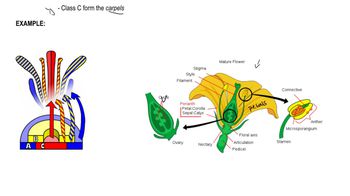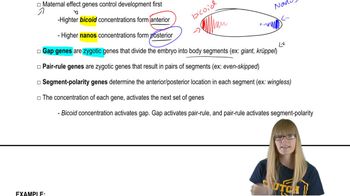Table of contents
- 1. Introduction to Genetics51m
- 2. Mendel's Laws of Inheritance3h 37m
- 3. Extensions to Mendelian Inheritance2h 41m
- 4. Genetic Mapping and Linkage2h 28m
- 5. Genetics of Bacteria and Viruses1h 21m
- 6. Chromosomal Variation1h 48m
- 7. DNA and Chromosome Structure56m
- 8. DNA Replication1h 10m
- 9. Mitosis and Meiosis1h 34m
- 10. Transcription1h 0m
- 11. Translation58m
- 12. Gene Regulation in Prokaryotes1h 19m
- 13. Gene Regulation in Eukaryotes44m
- 14. Genetic Control of Development44m
- 15. Genomes and Genomics1h 50m
- 16. Transposable Elements47m
- 17. Mutation, Repair, and Recombination1h 6m
- 18. Molecular Genetic Tools19m
- 19. Cancer Genetics29m
- 20. Quantitative Genetics1h 26m
- 21. Population Genetics50m
- 22. Evolutionary Genetics29m
14. Genetic Control of Development
Developmental Patterning Genes
Problem 7a
Textbook Question
Why do loss-of-function mutations in Hox genes usually result in embryo lethality, whereas gain-of-function mutants can be viable? Why are flies homozygous for the recessive loss-of-function alleles and viable?
 Verified step by step guidance
Verified step by step guidance1
Understand the role of Hox genes: Hox genes are crucial for the proper development of body plans in embryos. They determine the identity of segments along the anterior-posterior axis.
Loss-of-function mutations: These mutations result in the loss of normal function of the Hox genes, leading to incorrect segment identity and often embryo lethality due to critical developmental errors.
Gain-of-function mutations: These mutations can cause Hox genes to be expressed in new locations or at different times, potentially leading to viable organisms if the changes do not disrupt essential developmental processes.
Consider the genetic background: In some organisms, like flies, the presence of other compensatory genetic mechanisms or redundant pathways can allow for viability even with loss-of-function mutations.
Homozygous recessive viability: In flies, being homozygous for recessive loss-of-function alleles might still allow viability if other genes or pathways can compensate for the loss, or if the affected Hox gene is not critical for survival.
Recommended similar problem, with video answer:
 Verified Solution
Verified SolutionThis video solution was recommended by our tutors as helpful for the problem above
Video duration:
2mPlay a video:
Was this helpful?
Key Concepts
Here are the essential concepts you must grasp in order to answer the question correctly.
Hox Genes
Hox genes are a group of related genes that determine the body plan and the identity of segments in an embryo. They play a crucial role in the development of the anterior-posterior axis and are responsible for the proper formation of structures such as limbs and organs. Mutations in these genes can lead to significant developmental abnormalities, often resulting in embryo lethality.
Recommended video:
Guided course

Plant HOX genes
Loss-of-Function vs. Gain-of-Function Mutations
Loss-of-function mutations result in the complete or partial inactivation of a gene, which can disrupt essential developmental processes, leading to embryo lethality. In contrast, gain-of-function mutations enhance or alter the gene's activity, which may not be detrimental and can sometimes even confer advantageous traits, allowing the organism to survive and develop normally.
Recommended video:
Guided course

Functional Genomics
Recessive Alleles and Homozygosity
Recessive alleles require two copies to express a phenotype, meaning that flies homozygous for recessive loss-of-function alleles may still be viable if they possess a functional copy of the gene from another source or if the specific loss-of-function mutation does not completely eliminate the gene's activity. This can allow for normal development despite the presence of mutations.
Recommended video:
Guided course

New Alleles and Migration

 11:19m
11:19mWatch next
Master Segmentation Genes with a bite sized video explanation from Kylia Goodner
Start learningRelated Videos
Related Practice


